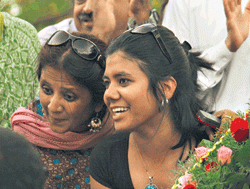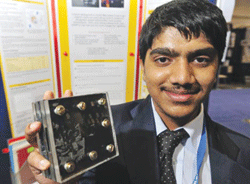 For the first time in her life, on May 21 Pune-based Krushnaa Patil (19) got the feeling of truly being on top of the world. On that day she became the first woman from Maharashtra — India’s most industrialised state (pop. 99 million) — and only the second individual from the state, to stand atop Mount Everest and take in the view from the highest point on Planet Earth. “I spent 35 minutes on the summit,” exclaims Krushnaa. “I touched my Golden Buddha, remembered my parents and took pictures. I then informed my base camp manager Pertemba Sherpa over the radio that I had done it.”
For the first time in her life, on May 21 Pune-based Krushnaa Patil (19) got the feeling of truly being on top of the world. On that day she became the first woman from Maharashtra — India’s most industrialised state (pop. 99 million) — and only the second individual from the state, to stand atop Mount Everest and take in the view from the highest point on Planet Earth. “I spent 35 minutes on the summit,” exclaims Krushnaa. “I touched my Golden Buddha, remembered my parents and took pictures. I then informed my base camp manager Pertemba Sherpa over the radio that I had done it.”
An alumna of the Symbiosis School & Junior College, Krushnaa was the only Indian in a multinational expedition organised by Aang Tshering Sherpa, founder chairman of the Asian Trekking Agency, Nepal.
Every year climbers succumb to the treacherous terrain on the icy slopes of the 8,848-metre-high (29,029 feet) Everest, with a record of 210 fatalities since Edmund Hilary and Tenzing Norgay first scaled the highest mountain in 1953. “I saw two avalanches at close quarters,” says Krushnaa. “The first occurred when I was above the ice fall, while the second killed one of our sherpas.”
Nor does the thrilling — and dangerous — sport of contemporary moun-taineering come cheap. To fund the expedition, her father, Madhav, a merchant navy officer, was obliged to raise a loan of Rs.35 lakh. “We approa-ched several companies and state government agencies for sponsorship but there were no takers,” recalls Madhav Patil. Nevertheless, Krushnaa’s triumph, grit and courage had a happy outcome. The Saraswat Bank waived the debt to celebrate her spectacular feat.
Following the classic path of a trekker and mountaineer, Krushnaa has developed a deep sensitivity to eco-conservation. “Our team collected five tonnes of garbage from the trails and slopes of Everest, comprising spent oxygen cylinders, food containers and camp gear. We introduced a ‘cash for trash’ scheme under which every sherpa was paid Rs.100 for every kg of garbage collected,” says Krushnaa, who is now actively involved in movements and networks of youth across the country to save the mountain from environmental degradation.
After a long summer of felicitations and celebrations with friends and family — including being honoured with the Rajiv Gandhi Award given to top achievers from different walks of life —Krushnaa is preparing for her next challenge. But she’s aware that she can’t go any higher!
Huned Contractor (Pune)
Vishnu Jayaprakash
 Vishnu Jayaprakash, a class XII student of Chennai’s well-known Chettinad Vidyashram School, has a dream to light up India’s villages by generating electricity using low cost, eco-friendly materials. Utilising animal waste as an energy source, he has developed a microbial fuel cell (MFC) which converts the chemical energy in cow dung into electrical energy with the help of organic microbes.
Vishnu Jayaprakash, a class XII student of Chennai’s well-known Chettinad Vidyashram School, has a dream to light up India’s villages by generating electricity using low cost, eco-friendly materials. Utilising animal waste as an energy source, he has developed a microbial fuel cell (MFC) which converts the chemical energy in cow dung into electrical energy with the help of organic microbes.
This innovation won him the national award of Intel’s Initiative for Research and Innovation in Science (IRIS) National Fair held in Kolkata last December, which qualified him to attend the Intel International Science and Engineering Fair 2009 in Nevada, USA, in May where his MFC was awarded second prize. “Lack of power is a crippling problem in rural India,” says Vishnu. “I’m working on slashing the cost of providing electricity to India’s 700,000 villages.”
“The prime input of the fuel cell is cow dung, which has enabled me to develop the low-cost and efficient MFC which requires no maintenance and has a lifetime of 70 years. I’ve also replaced the imported carbon paper electrodes in MFCs with indige-nously available, low-cost graphite sheet electrodes,” explains Vishnu, who perfected the fuel cell in June 2008 under the guidance of Dr. T.S. Natarajan, professor of physics at the Indian Institute of Technology, Madras, submitting it for evaluation to IRIS judges within two months. A joint initiative of Intel, the Union government’s Department of Science and Technology and Confederation of Indian Industry, IRIS (estb. February 2006) promotes and highlights the best research projects from pre-university students annually.
“My next step will be to replace Nafion — a proton exchange membrane in MFCs manufactured by DuPont —with suitable material that will reduce the cost by half, so that my invention can become affordable in rural India. I’ve applied for a project patent and am expecting to receive it soon,” says Vishnu.
Although a science buff who subscribes to and regularly reads, 12 science and technology publications per month, this budding young scientist is no nerd. He has bagged four bronze medals in national swimming champion-ships and has won the Best Overseas Entries Award of the Royal Astrono-mical Society UK, for his essay on planet Venus. But his passion is scientific research, which he wants to pursue at an Indian Institute of Technology or MIT Boston, he says with assurance.
Hemalatha Raghupathi (Chennai)